| Feb-18-02 | | knight: Black tripled his heavy pieces on the d-file and broke trough there. Black's 31...Qg4+ was a little bit shocking to the eye.His move 35...b5! was also powerfull and forcing. |
|
| Dec-15-09 | | vonKrolock: position after <35.♔xg4> 
click for larger view Now Schlechter found a sriking way of creating a pair of conected passed ♙♙s - <35...b7-b5> !! |
|
| Jun-25-12 | | backrank: What a wonderful game, equally interesting in opening, midgame and endgame! After playing through this, the Albin almost looks like a refutation of the queen's gambit ;) 30. ... Kd8! is seemingly played to avoid White's Bh3+, but in fact the king move is a preparation to the flashy 31. ... Qg4+!! which however doesn't win on the spot, but 'merely' leads to a won endgame, which is ultimately proven by 35. ... b5!!, creating two connected passed pawns. This is indeed a well-rounded game! |
|
Nov-28-18
 | | KEG: backrank's comment that this was "a wonderful game, equally interesting in opening, midgame and endgame!" says it all. The game demonstrates--if such were truly needed--that Schlechter was not only a fine positional player but also an excellent tactician when the occasion required. The game was played in Round 8 at Munich 1900. Both players were on a roll going into the game. Burn had gotten off to a poor start, losing two of his first three games, but then had won four games in succession, putting him at (5-2) and just one point off the lead. Schlechter had done even better, drawing his first two games but then winning five in a row, giving him a record of 6-1. Given the background of Burn and Schlechter, a careful positional contest might have been expected. Instead, Schlechter chose to play the Albin Counter-Gambit, and Burn countered with the super-sharp 4. e4?! line. Schlechter's triumph in the resulting cut and thrust battle allowed him to remain tied with Pillsbury for the lead at 7-1 before their 9th round encounter (which was a draw). 1. d4 d5
2. c4 e5!?
The Albin Counter-Gambit, hardly consistent with the usual superficial view of Schlechter's play. 3. dxe5 d4
This pawn was to be a thorn in Burn's hide for the rest of the game. White may be theoretically better here, but Black has plenty of play. 4. e4?!
4. Nf3 is usual here and notionally best and with best play yields White an advantage. After the text, a wild contest can be predicted even though thus far only pawns have been moved: 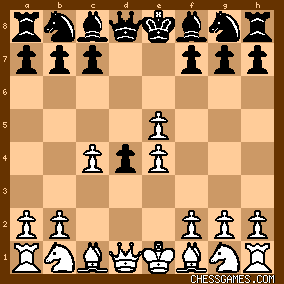
click for larger view4... Nc6
5. f4
I would have wagered that Burn here would play the solid 5. Nd2. The text, however, bolsters White's center and is far more enterprising. 5... g5?!
MOC-13 gives 5...f6 as best, and once again that may be the "best" move." The text, however, is definitely in the spirit of this game, and received a "!" in the Tournament Book. The wild opening deserves another diagram:

click for larger view6. Bd3
Hardly best. There was no need to blockade the d-pawn at this stage. The two main lines for White to consider here begin with 6. Nf3 (a solid build-up) and 6. fxg5?! (a no-holds-barred tactical fight). 6... gxf4
7. Bxf4 Nge7
8. Bg3
8. Nf3, 8. Ne2, and 8. Bg5 are also good options here. 8... Ng6

click for larger viewBurn's extra doubled e-pawn is worth little or nothing, and Schlechter, though nominally a pawn down, can be considered to have gotten the best of this sharp opening. Burn, perhaps feeling the initiative slipping away from him, decided to lash out. 9. Qh5?
Giving Schlechter an early opportunity to seize control of the game. The simple 9. Nf3 or 8. Nd2 were simpler and better. 9... Bb4+?
One of the few sloppy moves in this game by Schlechter. 9...Nb4! would have punished Burn's impertinent last move (e.g., 10. Qd1 Qg5 11. a3 NxB+ 12. QxN Qc1+ 13. Qd1 Qxb2). 10. Ke2?
It is hard to understand why Burn did not play 10. Nd2 with about equal chances instead of this dangerous King wander. The flaws in Burn's opening play is revealed in his bad position (despite Schlechter's having missed 9...Nb4): 
click for larger viewAs I will discuss in my next post on this game, from here Schlechter failed to capitalize on his advantage and Burn fought his way back into the game. The best in this contest, however, was yet to come. |
|
Nov-28-18
 | | KEG: Post II
In the diagrammed position with which I ended my last post, Schlechter could have maintained a significant advantage with 10...Nge5. His actual move, while not all that bad, was not as good: 10... Be6
11. Nf3 Qd7
Either 11...Be7 or 11...h6 would have been better. 12. h3 Be7
"Threatening Nb4 and Nd3" (Tournament Book).
13. a3
To stop Black from playing Nb4.
13... Na5
Necessary to be able to play c5, even though the Knight winds up returning to c6 on his 15th move. 14. Nbd2 c5
15. Rhc1
15. Rab1 and 15. Rhb1 were other reasonable options. 15... Nc6
15...h6 or 15...0-0-0 immediately were other possibilities. 16. Kf2
16. Kf1 was more accurate.
16... Rg8
"!"--Tournament Book.
Schlechter's plan to load up on the g-file was to play a key role in this game. The position was now:

click for larger view17. b3
This does little to aid White's cause. Burn should have played 17. b4. If 17. Kg1? Bxh3! wins. (Tournament Book)
17... 0-0-0
18. Bh2
There was no need for this. 18. b4 was best.
18... Rdf8
Better still was 18...h6 to be able to post his Bishop on g4. This is not really a pawn sacrifice since if 18...h6 19. Qxh6 Rh8! is a killer. 19. Rg1?
b4 is still the right move. 19. g4 was another option. 19... Qd8?
He should have played either 19...h6 or 19...f6. But this was to be Schlechter's last misstep in this game. From here, his play was both precise and thrilling. 20. Ke2
As the risk of losing face, Burn should have admitted the error of his last move and played 20. Rgd1. 20... Nh4
This left:

click for larger viewBurn had the worst of it to this point, but the game was highly complex and Burn had all kinds of chances. But,as I will discuss in my next post on this game, Burn erred in this position and got blown away by Schlechter's deadly tactical skill. |
|
Nov-29-18
 | | KEG: Post III
Burn was already in trouble after 20...Nh4. His 21st move was a serious mistake, and Schlechter never gave him another chance. 21. NxN?
This only fueled Schlechter's attack. The Tournament Book's suggested 21. g4 would have been a better try, but would have lost after either 21...h6 or 21...NxN. 21. g3 would have been slightly better still, though Burn would still have been in trouble after 21...NxN. Perhaps the best chance was offered by 21, Kf2. In any case, Burn would have been struggling to keep his head above water. The text, however, was a clear loser, as Schlechter proceeded to demonstrate brilliantly and with ruthless efficiency. 21... BxN
22. Nf3?
Another poor move by Burn. To have any chance, he had to play 22. Bf4 (and if then 22...Bg3 23. Bh6 with some chances after 23...Nxe5 24. BxR QxB though Schlechter's attack would still be strong) or perhaps 22. g4 (though 22...Bg5 then looks scary). After the text, what followed for Burn was a catastrophe, the position now being: 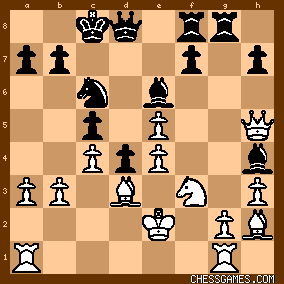
click for larger view22... Bg3!
23. BxB
The main alternative, 23. Qh6, was no better.
23... RxB
This left:

click for larger viewAs Knight correctly notes, Schlechter now had an unstoppable winning plan: triple his heavy pieces on the g-file [Knight's reference to the "d-file" was presumably a typo]. Burn, so far as I can see, had no plausible way to counter this strategy. 24. Qh6
24. Kf2 immediately seems the only alternative, but it would merely transpose into the line in the game after 24...Rfg8. 24... Rfg8
Beginning the g-file pile-up.
25. Kf2 R8g6
"!"--Tournament Book.
26. Qf4
If instead 26. Qxh7, then--as pointed out in the Tournament Book--26...Nxe5! 27. NxN Qf6+ 29. Nf3 Qf4 and Black, though a piece down, has a winning attack. 26... Qg8!
Continuing with his plan.
27. Bf1
The position now was:

click for larger viewBlack to move and win:
27... Bxh3!
As any chess computer will tell you, Schlechter here had an even more decisive winning line beginning with 27...Qg7, but what flesh and blood player would select that rather than Schlechter's pretty winning combination. 28. gxB RxN+
Much better than 28...RxR (though that also probably wins). 29. KxR
29. QxR was no better.
29... RxR
This left:

click for larger viewMaterial is nominally even (counting Burn's feeble isolated d-pawns as equal to Schlechter's monster connected c and d pawns), so Burn played on. That the position is as clearly won as it appears to be was promptly demonstrated by Schlechter, as I will discuss in my next post on this game. |
|
Nov-29-18
 | | KEG: Post IV
Schlechter's method of finishing off Burn was as aesthetically pleasing as it was effective. 30. h4
Looks feeble, but I can find nothing better. The idea, of course, was to be able to harass Schlechter's King with Bh3+. 30... Kd8!
As backrank correctly pointed out on this site over 6 years ago, this move not only avoids Bh3+ but--more importantly--allows the pretty combination Schlechter sprung on his next move, which would not work with Black's King on c8 [since the Queen would then be captured with check]. 31. b4
Perhaps anticipating the coming endgame and hoping to break up Schlechter's pawn mass. But, as will soon be apparent, Schlechter has seen farther. The position was now:
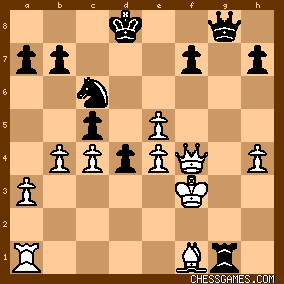
click for larger view31... Qg4!
"!"--Tournament Book.
As on move 27, any computer will spit out prosaic wins wins beginning with 31...Qg7 or 31...Qg6. But, and again as on move 27, what human chessplayer would pass up the chance to win brilliantly as Schlechter did! 32. QxQ Nxe5+
The point!
33. Kf4 NxQ
This left:

click for larger view34. Ra2
The alternative, 34. Rb1 would likewise have allowed Schlechter to have finished brilliantly, i.e., 34...Ne3 35. Bd3 RxR 36. BxR b5! 37. cxb5 [37. bxc5 or 37. e5 would have been even worse] c4 and White cannot stop the advance of the Black c-pawn]. 34... RxB+
35. KxN
The position was now:

click for larger view35... b5!
"Powerful and forcing" (Knight).
"!!"--Tournament Book.
"A striking way of creating a passed pawn." (VonKrolock). "Creating two connected passed pawns." (backrank). It is difficult to overstate the beauty of this move. 36. cxb5 c4
37. Rd2 d3
The d-pawn, which had advanced to d4 back on move 3, now leaves Burn without resource: 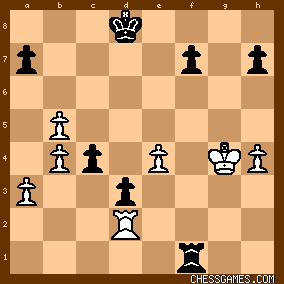
click for larger viewI will discuss Schlechter's final mopping up operation from hr in my next and final post on this game. |
|
Nov-29-18
 | | KEG: Post V
After 37...d3, Burn could safely have resigned.
38. a4
This effort at counterplay was too late to change White's fate. 38... c3
"!"--Tournament Book.
40. Rxd3 c2
41. Rc3 c1(Q)
42. RxQ RxR
This left:

click for larger viewAll that remained was for Schlechter to pick off White's pawns. 43. Kg5 Rc4
44. b6 axb6
45. axb6 Rxb4
If Schlecther enjoyed melodrama, he could have won with 45...Rxe4 46. b7 Re5+ (or just 46...Rxb4). 46. Kh6 Rxb6+
47. Kxh7 Rb4
48. h5 Rxe4
49. h6 Kf6
The position was now:
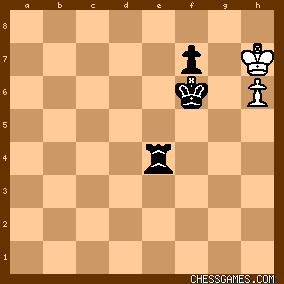
click for larger view0-1 |
|
|
|
|





